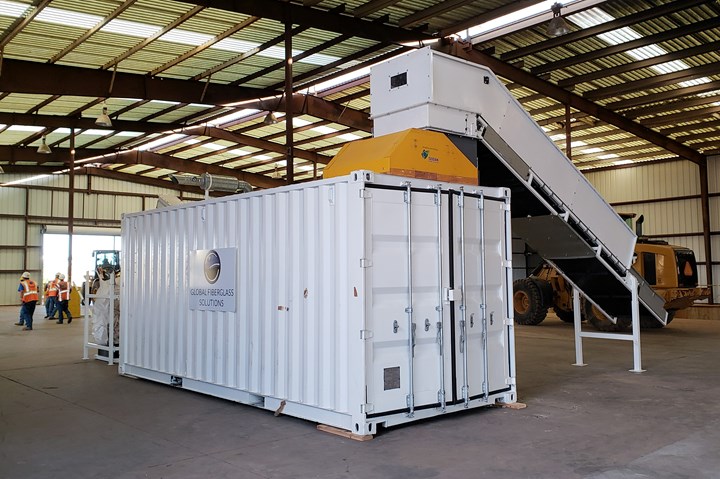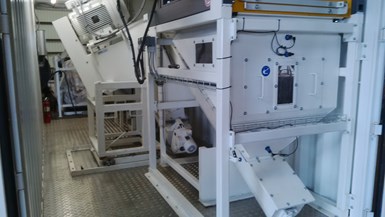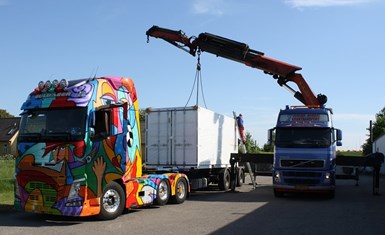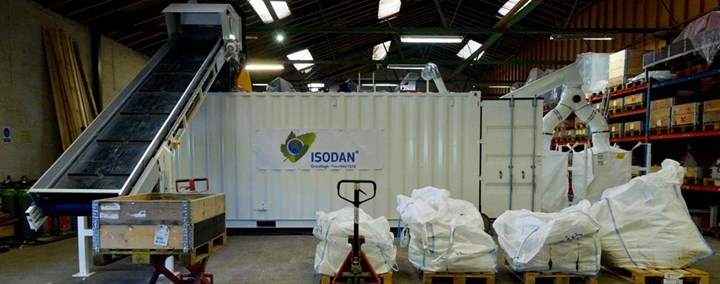
Isodan Engineering ApS started out as an insulation company that developed a mobile paper recycling system to solve cost challenges with transporting materials. More recently, the company has extended its expertise to composites, with a mobile system for mechanically breaking down composite end-of-life (EOL) structures or scrap into reusable materials. Pictured here (and throughout) is the company’s first customer system, delivered to recycling company Global Fiberglass Industries. Photo Credit, all images: Isodan Engineering ApS
Wind blade operators, OEMs and others in the composite wind blade supply chain are increasingly seeking and ramping up solutions for recycling and repurposing wind blades at their end of life (EOL). One challenge for effective and widespread wind blade recycling is that transportation of these large structures to the limited number of existing recycling facilities can be prohibitively expensive.
Isodan Engineering ApS (Holeby, Denmark) is one company presenting a potential solution, with its mobile, containerized recycling plants designed to be able to travel between wind farms and break wind blades down on site into reusable shreds or pieces.
Isodan got its start in 1974, selling paper-based building insulation materials — which remains the company’s key business. In the 1980s, aiming to make its materials and process more sustainability-focused, the company began using recycled newsprint and other paper for its insulation. However, Isodan serves customers globally, and though paper is inexpensive, moving large volumes of shredded paper to and from the company’s Denmark facility for shredding turned out to be costly. Ultimately, Isodan developed a mobile, shipping container-based paper recycling system that could be transported to the site where insulation would be installed. In this small, localized recycling plant, newsprint is placed in one end, and shredded material is deposited into bags on the other end.

Isodan’s recycling system is designed with a customizable, two-step process. The first step is a “pre-shredder” that breaks the structures down to a specified length. A second “refiner” step can include further shredding, grinding or other processes to produce the final product for reuse.
The company has now been using and demonstrating this technology for paper and insulation for 30 years. More recently, Isodan has leveraged its mobile recycling technology into a similar solution for on-site mechanical recycling of composite wind turbine blades.
“With insulation materials, the big issue is that paper is a cheap material but takes up a lot of physical space, which can make the transport costs high,” explains Morten Nielsen, owner of Isodan Engineering ApS. “Now, you have basically the same battle with the wind industry and fiberglass recycling. You have the wind turbine blades, which are enormous and cost a lot to transport, so the solution would be to break them down into a transportable size on location.”
The system is designed as a two-step process, run by one operator. Large wind blade pieces are inserted into one end, where they enter a “pre-shredder” station and are shredded into finer particles. They travel by conveyor to a secondary “refiner” station for further processing to the specified size and length requirements. Nielsen notes that this second step can be customized as needed, and may be one simple grinding or shredding stage, or a multi-step process to produce the required material. The entire system operates under negative pressure to eliminate the airborne dust that is a typical safety concern for fiberglass shredding or recycling. At the end of the process, bags of shredded material can be collected straight from the system, to be repurposed into new applications.
Isodan’s systems can be built in 20- or 40-foot shipping containers, designed to plug into a power source at a facility or to be adapted with its own generator for use in the field.
According to Nielsen, the output depends on the size of the unit and how refined the final product needs to be, though a 20-foot unit can process between 500 and 1,500 kilograms of material per hour.
“We offer a front-end solution for repurposing and granulating these composite materials into lengths that can then be repurposed into other useful products,” says Finn Christensen, export manager at Isodan Engineering ApS.
The systems are custom designed per customer, built directly into 20- or 40-foot shipping containers so that they can be easily transported via truck, rail or boat. They can be installed as stationary machines within a recycling facility, or used as a mobile plant with a separate power generator.

The idea is that these mobile units could be transported as needed to wind farms, boatyards or recycling facilities, eliminating the need to transport large amounts of EOL parts or scrap to a dedicated facility.
The first machine was developed for recycling company Global Fiberglass Solutions (Bothell, Wash., U.S.). According to Christensen, Global Fiberglass Solutions was well-versed in crushing and granulating fiberglass wind turbine blades to produce reusable materials such as its “ecopoly” compounded pellets and panels for construction applications, “however, that process was very dusty and therefore hazardous.” Isodan was chosen for its self-contained, dust-free technology, and delivered its first customer unit to Global Fiberglass Solutions in July 2018.
Christensen notes that interest in Isodan’s systems has grown over the past year or so as more companies look for sustainability solutions — not just for EOL wind blades, but for fiberglass boat hulls in the marine industry, and fabricators looking to repurpose fiberglass manufacturing scrap as well.
“It’s a rapidly growing part of our business,” Nielsen says. However, one of the biggest challenges that still exists within the industry, Nielsen says, is that solutions still need to be matured for the reused material. He adds, “In early years, nobody wanted to talk much about the recycling process, but that has changed a lot. I think we’d probably call ourselves an early bird in this market in terms of coming up with a commercial solution, and we’re continuing to see a lot of interest.”
Related Content
Composites end markets: Batteries and fuel cells (2024)
As the number of battery and fuel cell electric vehicles (EVs) grows, so do the opportunities for composites in battery enclosures and components for fuel cells.
Read MorePolar Technology develops innovative solutions for hydrogen storage
Conformable “Hydrogen in a Box” prototype for compressed gas storage has been tested to 350 and 700 bar, liquid hydrogen storage is being evaluated.
Read MoreNCC reaches milestone in composite cryogenic hydrogen program
The National Composites Centre is testing composite cryogenic storage tank demonstrators with increasing complexity, to support U.K. transition to the hydrogen economy.
Read MoreRTM, dry braided fabric enable faster, cost-effective manufacture for hydrokinetic turbine components
Switching from prepreg to RTM led to significant time and cost savings for the manufacture of fiberglass struts and complex carbon fiber composite foils that power ORPC’s RivGen systems.
Read MoreRead Next
Moving toward next-generation wind blade recycling
Suppliers, fabricators and OEMs across the composite wind blade supply chain ramp up existing technologies, develop better reclamation methods and design more recyclable wind blades.
Read MoreDeveloping bonded composite repair for ships, offshore units
Bureau Veritas and industry partners issue guidelines and pave the way for certification via StrengthBond Offshore project.
Read MoreVIDEO: High-volume processing for fiberglass components
Cannon Ergos, a company specializing in high-ton presses and equipment for composites fabrication and plastics processing, displayed automotive and industrial components at CAMX 2024.
Read More

.jpg;width=70;height=70;mode=crop)







.jpg)














